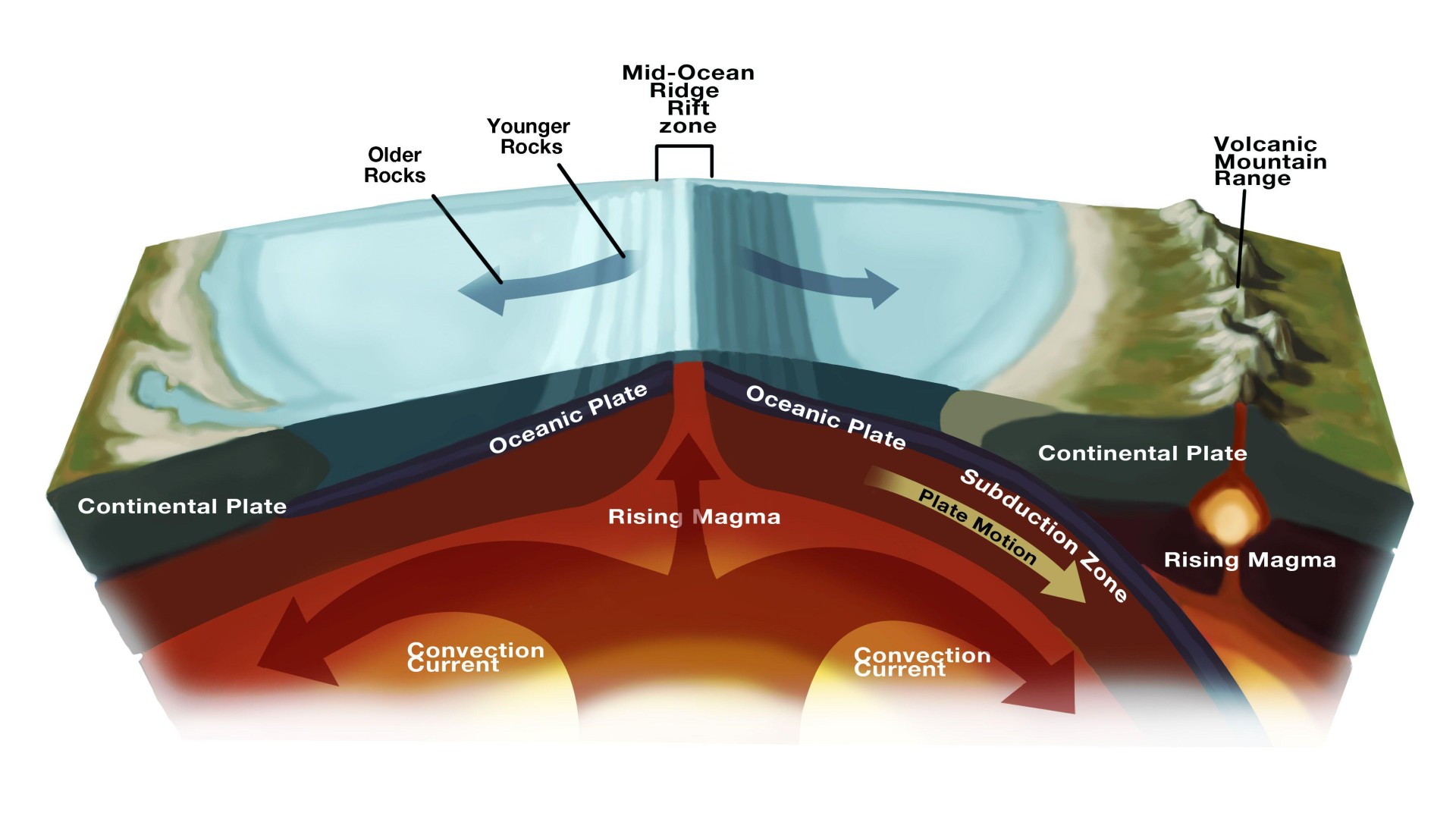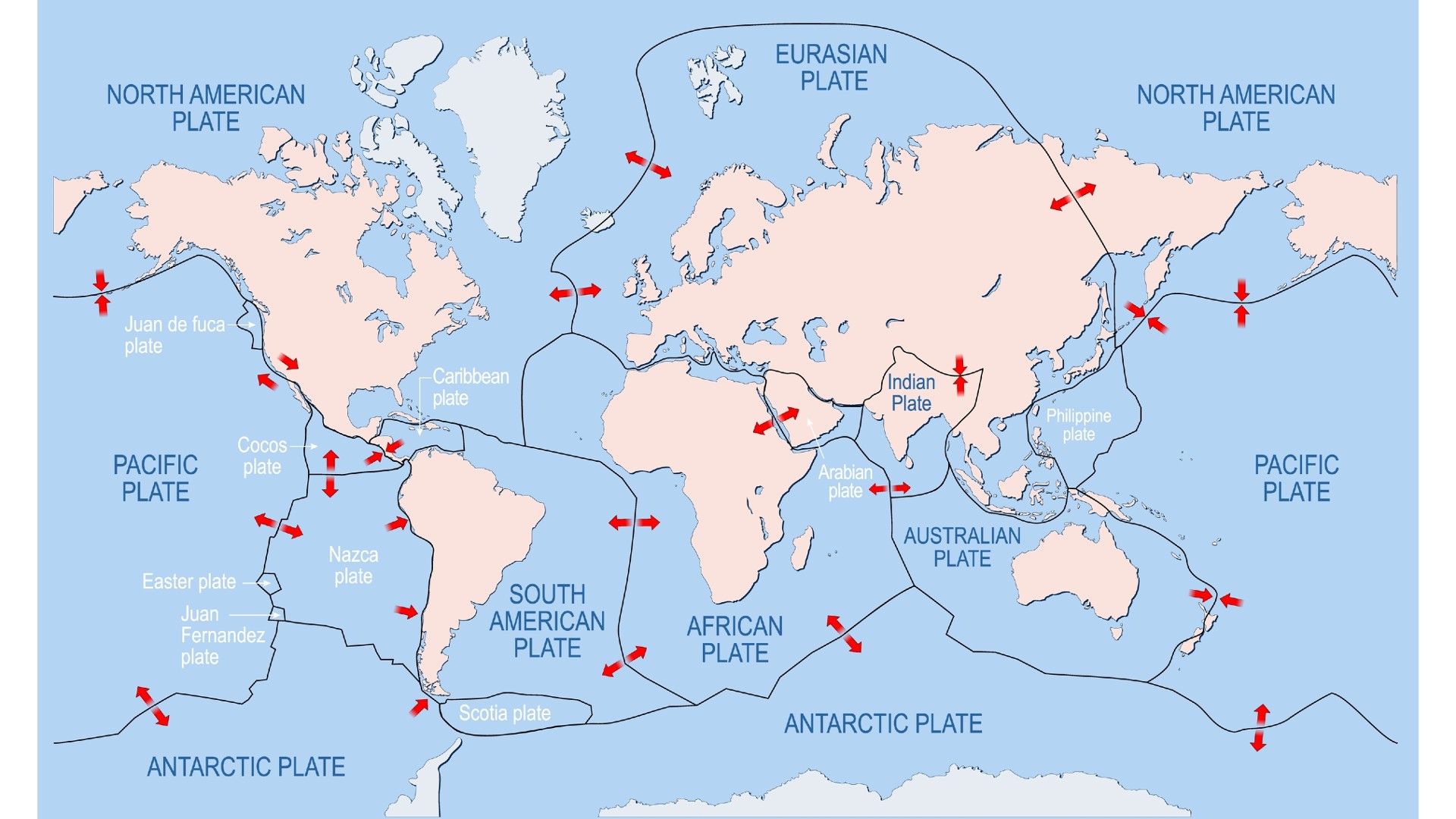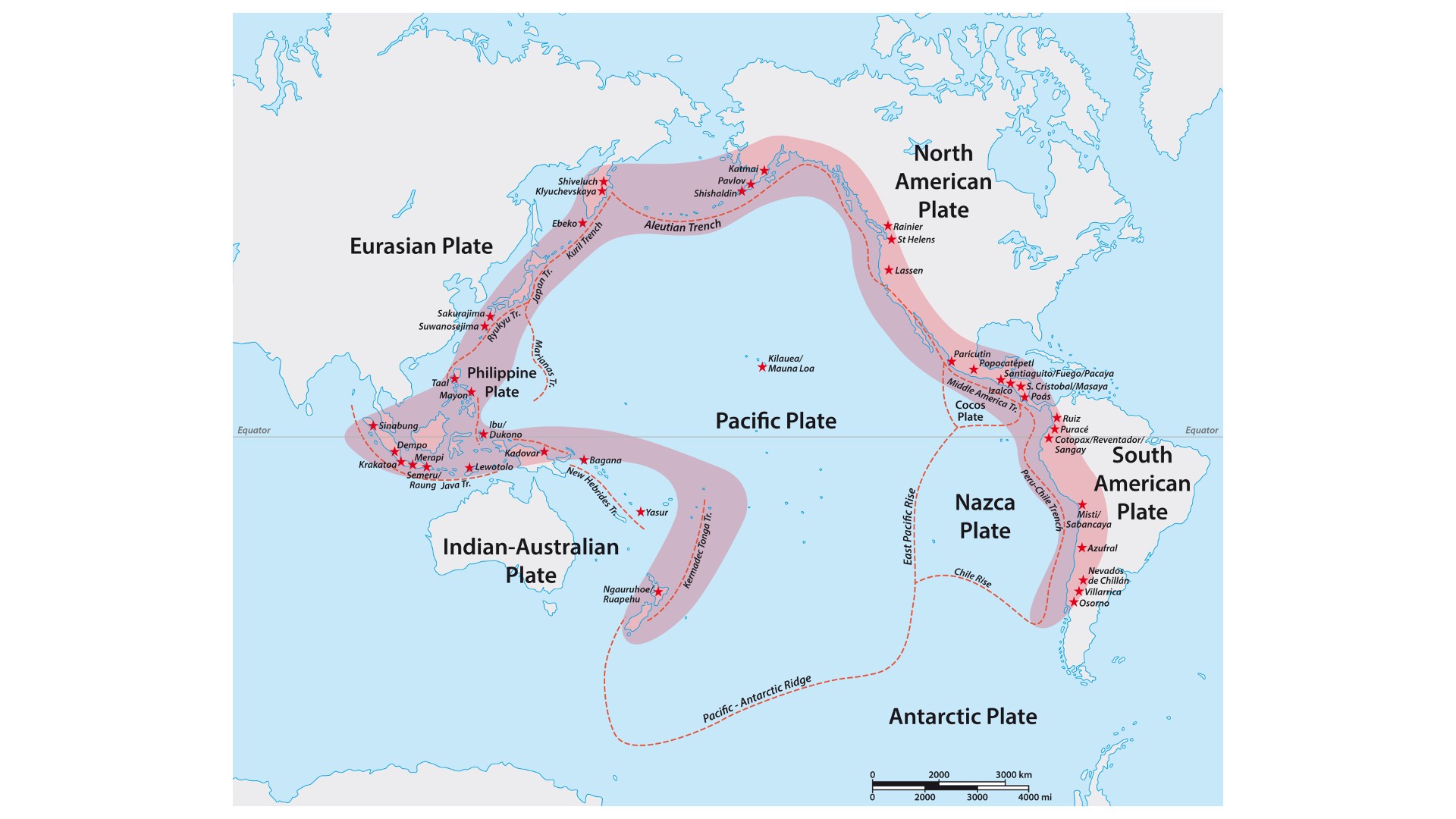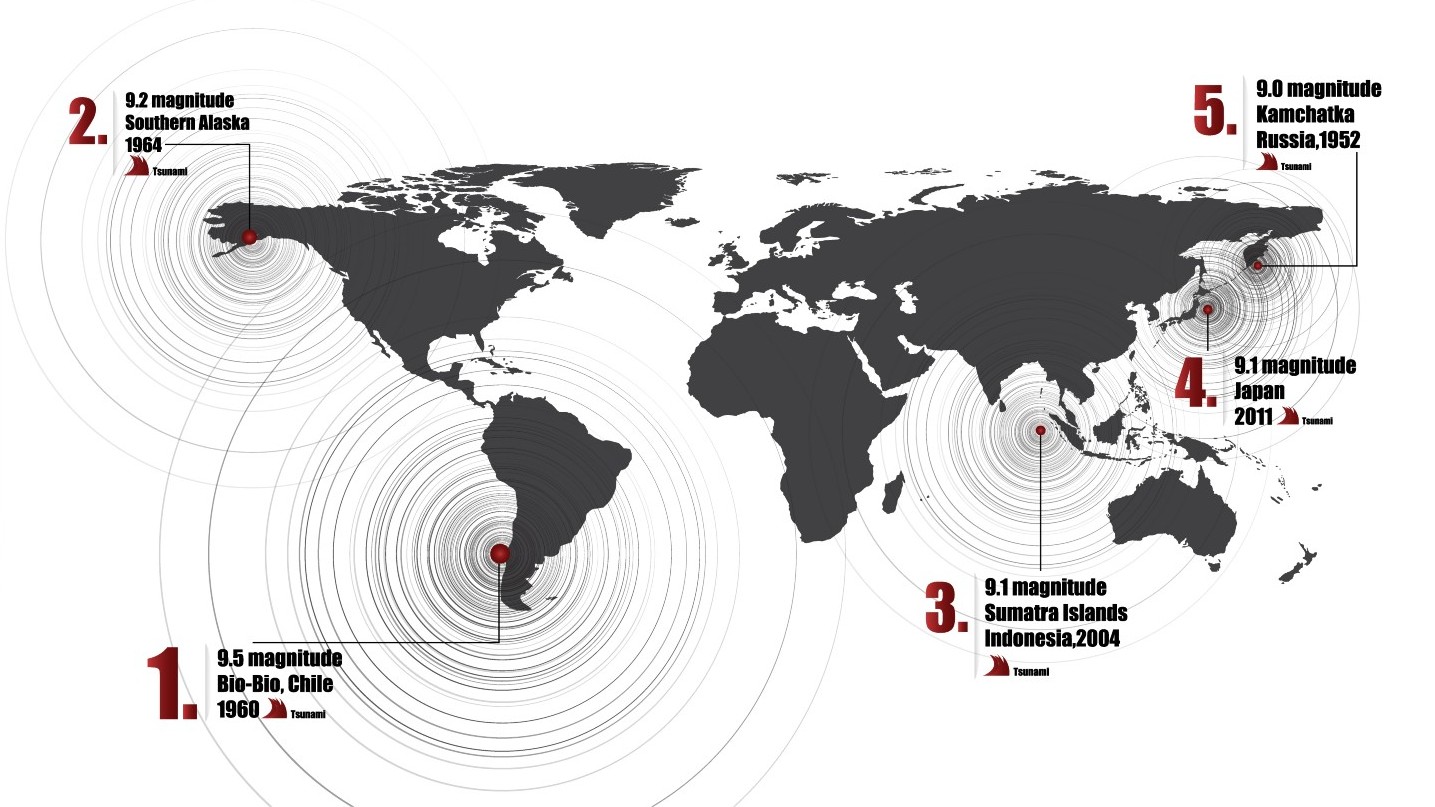What is a subduction zone?

One of the biggest crash scenes on Earth, a subduction zone is a spot where two of the planet's tectonic plates collide and one dives, or subducts, beneath the other, according to the National Oceanic and Atmospheric Administration (NOAA). This tectonic process can produce some of the planet’s most powerful earthquakes, tsunamis and volcanoes.
What happens at a subduction zone?
Tectonic plates are pieces of the Earth’s rigid outer layer that slowly move across the planet's surface over millions of years, according to NOAA. (This is the main tenet of plate tectonics, the theory that portions of Earth's shell glide over the lower mantle, taking continents with them.) That outer layer, known as the lithosphere, consists of the Earth’s crust and the upper section of the mantle, a dense, hot layer beneath the crust, according to the U.S. Geological Survey (USGS). When two tectonic plates meet at a subduction zone and one slides underneath the other, this lithosphere material curves down into the hot mantle.
This subduction process frequently occurs because of the two different types of lithosphere that make up tectonic plates: Continental and oceanic. Because oceanic material is denser than continental lithosphere, when the two collide at a subduction zone, the oceanic portion sinks into the mantle beneath the more buoyant continental lithosphere, according to NOAA.
Subduction zones can also occur when both colliding plate sections consist of oceanic material. In these cases, older, denser oceanic lithosphere sinks below younger, more buoyant oceanic lithosphere. (New oceanic lithosphere forms at the spots where plates separate, allowing hot mantle material to rise to the surface. As it moves away from those boundaries, this lithosphere cools and gets denser, according to Columbia University. Thus, older oceanic lithosphere can more easily sink.)
The sinking plate, or "slab," at a subduction zone tends to bend at an angle of about 30 degrees from Earth's surface, though some angles are flatter or steeper than this, according to the University of Colorado. Sometimes, the slabs may tear, like a gash in wrinkled paper, and break off and fall into the mantle, according to a 2008 study in the journal Tectonics. Modeling research in 2021 revealed that these sinking slabs don’t vanish, but rather weaken and become pliable, Live Science previously reported.
Tectonic plate smash-ups don’t always result in a subduction zone. When two sections of continental lithosphere converge, it creates a collision zone and the plates crumple together like crashing cars, pushing up material, according to the California Academy of Sciences in San Francisco. The massive Himalaya mountain chain was created this way, when the Indian tectonic plate slammed into the Asian plate.
Where do subduction zones typically occur?
Subduction zones occur in a horseshoe shape around the edge of the Pacific Ocean, offshore of Washington state, Canada, Alaska, Russia, Japan and Indonesia and down to New Zealand and the southern edge of South America, according to NOAA.
Get the world’s most fascinating discoveries delivered straight to your inbox.
Called the "Ring of Fire," these subduction zones comprise “the most seismically and volcanically active zone in the world,” according to the USGS, responsible for more than 80% of the world's biggest earthquakes and most of the planet’s active volcanoes, according to NOAA.
How do subduction zones form?
The formation of subduction zones has been difficult to study, because these zones destroy material by their nature, Live Science previously reported. A 2021 study, however, investigated a relatively young subduction zone at the Puysegur Trench south of New Zealand to probe the origins of subduction. There, the subduction process got started via stretching and shifting of the submerged "secret" Zealandia plate, which surrounds and encompasses New Zealand, researchers found. That movement repositioned the plate to allow oceanic crust to subduct beneath it, the scientists said.
Sometimes, subduction can begin spontaneously, without forces of collision between plates, a 2004 study in the journal Earth and Planetary Science Letters found. This happens as lithosphere becomes unstable and sinks under the force of gravity, the study said, and as Live Science previously reported, oceanic lithosphere may grow so old and dense that it collapses and spontaneously forms a subduction zone.
When did subduction start?
That modeling research from 2021 also suggested that in the younger, hotter Earth of roughly 1 billion years ago, modern plate tectonics wouldn’t work. That’s because subducting slabs would break up quickly and cease pulling the material behind them into the mantle. The action of plate tectonics depends on subduction, because "the sinking of lithosphere in subduction zones provides most of the power for plate motions," according to a 2018 review published in the journal GSA Today.
However, the history of subduction remains controversial, and researchers in 2022 detected evidence of ancient subduction in eclogite, a rare rock dating to 2.5 billion years ago that formed from subducting oceanic material. And in a 2021 study, scientists described evidence of plate tectonics from 3.6 billion years ago preserved in zircon crystals from Australia, Live Science previously reported.
Experts introduced the term subduction in 1970, as the theory of plate tectonics was taking hold, though descriptions of the phenomena appeared as early as the 1960s, according to the 2018 review in GSA Today. Seismographs placed around the globe in the 1960s to detect nuclear tests also aided in the development of tectonic theory and subduction zone science, according to the National Park Service. Now, new instruments can precisely track the shifting tectonic plates, according to the University NAVSTAR Consortium (UNAVCO), a nonprofit for geoscience research and natural hazard mitigation.
"We can see very clear pictures of how the plates move, mostly due to GPS data," said Vasily Titov, senior tsunami modeler for NOAA's Center for Tsunami Research in Seattle, Washington.
Why do earthquakes occur in a subduction zone?
Shoving two massive slices of Earth's crust together resembles rubbing two pieces of sandpaper against each other. The crust sticks in some places, storing up energy that is released as earthquakes, according to the USGS. These "megathrust earthquakes" are the largest temblors on Earth, according to Natural Resources Canada. The biggest ever recorded include a magnitude 9.5 in Chile in 1960 and a magnitude 9.2 in Alaska in 1964, both on subduction zones, according to USGS. Because they occur where oceanic lithosphere subducts beneath continental or other oceanic lithosphere, these quakes strike along coastlines or in the ocean.
Smaller earthquakes also strike all along the descending slab of a subduction zone, according to USGS. Seismic waves from these temblors and tremors can help scientists "see" inside the Earth, much as computed X-ray tomography, or CT scans, allow medical doctors to peer inside the human body.
Why are subduction zone earthquakes the biggest in the world? The main reason is the enormous size of the faults in subduction zones, according to USGS. The greater the area colliding, the more energy is stored up and released in the process. "Subduction zones are huge boundaries, so they generate very large earthquakes," Titov told Live Science. The Cascadia subduction zone stretches about 600 miles (960 kilometers) from Northern California to British Columbia, Canada, located about 70 to 100 miles (100 to 160 km) offshore, according to the Oregon Department of Emergency Management.
Megathrust quakes occur repeatedly along subduction fault lines as energy gets stored up and then released. The Cascadia zone has caused a mega quake an estimated 13 times over the last 6,000 years — about one every 500 to 600 years on average — and this will continue to happen, according to Natural Resources Canada.
In 2020, researchers found that a fault in the Cascadia zone could one day cause a massive earthquake off the coast of Portland, Live Science previously reported. Known as the Gales Creek fault, it could today produce a quake of magnitude 7.1 to 7.4, enough for some very strong, possibly life-threatening shaking, though such quakes are rare in this fault, researchers said.
In 1700, this subduction zone triggered a gigantic earthquake, measuring an estimated 8.7 to 9.2 in magnitude and spawning a tsunami that reached Japan. Researchers found in 2021 that what looks in the geologic record like one monster quake may have actually consisted of several relatively smaller quakes, Live Science previously reported. These smaller earthquakes would still have been extremely powerful, however, so a series of such quakes today could be even worse for the region than one larger temblor. That makes it important to figure out the most likely past and future scenarios, the researchers said.
Do subduction zones cause tsunamis?
A megathrust earthquake along a subduction zone can jostle the surface of the ocean floor vertically, causing a tsunami, or giant sea wave, according to USGS. This can happen with earthquakes larger than a magnitude 7.5, USGS says. However, other factors affect whether or not a subduction zone earthquake will cause tsunamis; for example, the earthquake must happen in a shallow marine region, USGS says.
Some earthquakes can also trigger tsunamis by setting off underwater landslides, according to the UN International Tsunami Information Center.
Subduction zones are frequently along coastlines, given that these zones occur where oceanic and continental plate material meet. So tsunamis will frequently be generated close to where people live; however, "There's a silver lining," Titov said. "If these earthquakes happened underneath a city, the city would have no chance."
Government agencies such as NOAA in countries around the Pacific Ocean monitor the tsunami threat from subduction zones, providing warnings to those in danger. These waves may strike quickly, too, as tsunamis can move as fast as jet planes — over 500 mph (800 km/h), according to NOAA. For coastal areas near an earthquake, the giant waves may arrive in minutes.
Why do volcanoes form at subduction zones?
As a tectonic plate slides into the hotter mantle, the increased heat and pressure release surface seawater in the slab and water trapped in its minerals, according to San Diego State University (SDSU). These fluids rise into the upper mantle, lowering the melting temperature of rocks there and forming magma (molten rock). Magma above a subducting slab will rise into the crust and form an arc of volcanoes, according to Columbia University in New York City. (The hot, molten magma rises because it is less dense and more buoyant than the rock around it, according to the Arizona Geological Survey.)
When oceanic lithosphere subducts beneath continental material, a belt of volcanoes called a volcanic arc forms on the continental crust. This happened in the Pacific Northwest of the U.S. and Canada, for example, in the Cascade Volcanic Arc, which includes Mount Rainier in Washington state, according to SDSU. When an oceanic plate drops beneath another oceanic plate, it forms a string of volcanoes known as an island arc, such as Alaska's Aleutian Islands along the Ring of Fire.
In 2021, those islands scored a triple whammy, with three volcanoes erupting simultaneously, a rare but not unheard of event, Live Science previously reported. The Toba volcanic eruption in Indonesia, the largest volcanic eruption in the past 2 million years, was from a subduction zone volcano, according to Oregon State University.
Additional resources
Read how subduction zones helped create some of the beautiful landmarks found in U.S. parks at the U.S. Park Service. Learn how to prepare for tsunamis with the Red Cross Tsunami Survival Guide or the U.S. Department of Homeland Security’s Ready.gov: Preparing for Tsunamis page. Follow seismic activity in the U.S. with the USGS earthquake monitoring site. Read about the earthquake dangers posed to the Pacific Northwest in the book "Cascadia's Fault: The Coming Earthquake and Tsunami That Could Devastate North America" (2011, Counterpoint) by journalist Jerry West.
This article was originally written May 7, 2015 by Live Science contributor Becky Oskin and has since been updated on August 31, 2022 by Michael Dhar.

Michael Dhar is a science editor and writer based in Chicago. He has an MS in bioinformatics from NYU Tandon School of Engineering, an MA in English literature from Columbia University and a BA in English from the University of Iowa. He has written about health and science for Live Science, Scientific American, Space.com, The Fix, Earth.com and others and has edited for the American Medical Association and other organizations.
- Becky OskinContributing Writer





